You are viewing 1 of your 1 free articles
Different speeds of attack
This session is about developing the ability to attack at speed with immediate forward passing and forward running, combined with the ability to build controlled attacks against a set defensive structure.
| Area | 72x54 yards |
| Equipment | Balls, bibs, cones, 2 full size goals |
| No. of Players | 22 players + 2 goalkeepers |
| Session Time |
Main practice: 20mins, 9v9 game: 20mins |
This session is about developing the ability to attack at speed with immediate forward passing and forward running, combined with the ability to build controlled attacks against a set defensive structure.
At Manchester United the players really enjoy this practice, as it involves so many different attacking and defending elements in one dynamic, competitive and game-realistic session.
The set-up allows us to develop the exciting high-speed attacks that are key to our desired playing style at United. It also gives us the opportunity to practise breaking down compact and organised defences.
We run the practice every two to three weeks when we do not have a midweek game. Within our physical periodization, the practice will usually take place three days before match day, when we want an intensive output of high-speed running. We will alter small details within the practice depending on the next opponents.
What do I get the players to do?
Different speeds of attack
We set up in an area of 72x54 yards using the space between the two penalty boxes of our pitch, with a goal and a goalkeeper at each end. We’re using 22 outfield players, split into three teams of six and four neutrals who support the attack. One team starts at each end and defends that goal, and the third team are the attackers and they start in the centre of the pitch. Two of the neutrals are fixed in each half. We are also using three servers, two on one side of the pitch and one on the other side.
We run two types of attack with each team. We rotate the attacking team as follows…
Fast attack by blues
Server 1 passes a ball into the blue attacking team in the centre. They attack the reds at one end of the pitch as quickly as possible, using the support of the two neutral yellow players in that half, as shown [1a]. The attacking team has a maximum of 10 seconds to score. If the defenders win the ball, they should clear it out of the area.
1a
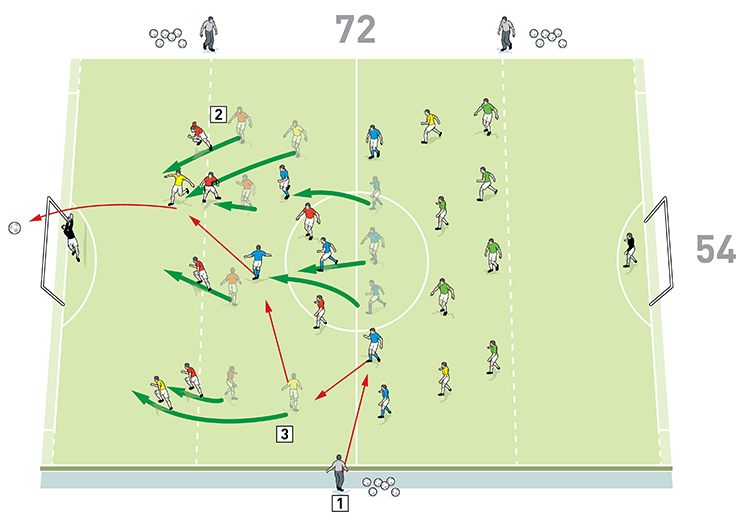
2. The red defending team starts with a high defensive line
3. The blue attacking team must try to score and can use the support of the two yellow neutral attackers in the half they are attacking
Controlled attack by blues
After the first attack finishes with either an attempt at goal or a successful defensive action, Server 2 plays a ball into the blue attacking team, as shown [1b]. In this second attack, the red defending players start in a much deeper position and the attackers must look to penetrate the defence either by going around, through or over the defensive structure.
1b
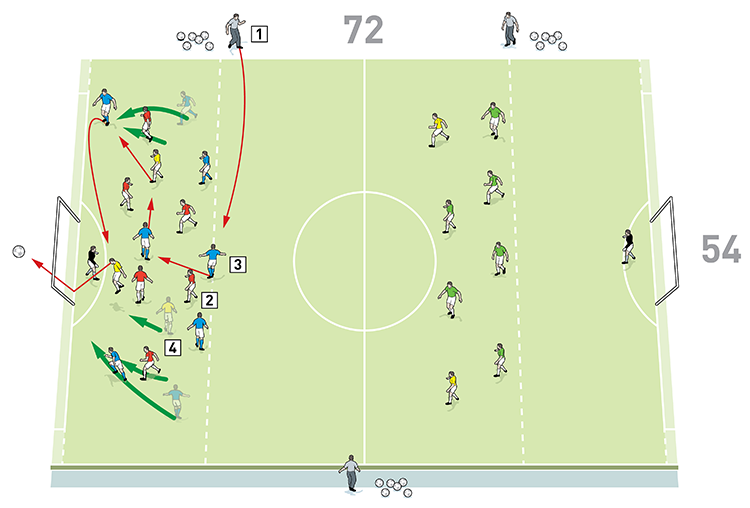
2. For this second attack the red defending team starts in a much deeper position
3. The attackers try to score by penetrating around, through or over the defence
4. The blues can still use the support of the two yellow neutrals in that half to give them an overload
Fast attack by reds
When the second attack is finished, the red defending team now receives a ball from Server 1 and they immediately pass forwards to one of the yellow neutral attackers in the other half of the pitch and then counter-attack that end as quickly as possible against the green defending team, as shown [1c]. The reds are now the new attacking team.
1c
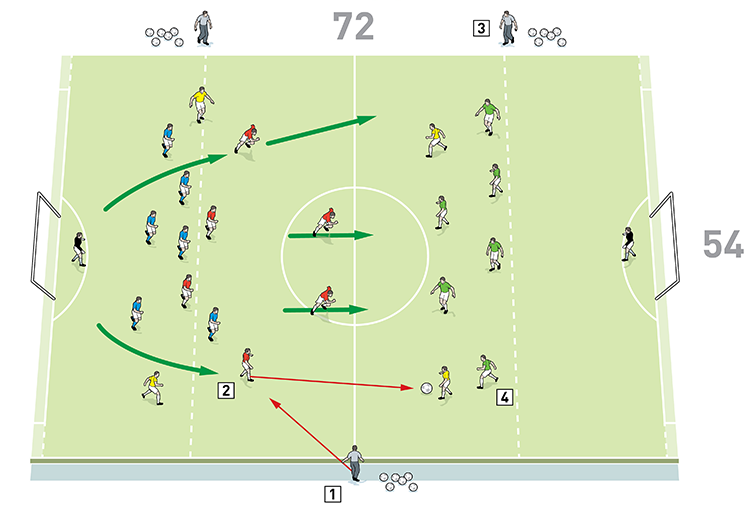
2. The reds must pass forwards to a yellow floater in the other half. The reds are now the new attacking team and must quickly try to score. Allow them 10 seconds
3. After this attack is dead, Server 3 passes a ball to the new attackers (the reds) in the final quarter. They must find a way to get past the deeper defence to score with a controlled attack, similar to diagram 1b
4. The red attacking team makes two attacks and then the green defending team become the attackers and they make two attacks. Play continues in this pattern
The session continues with the attacking team always making two attacks (one fast and one controlled), and with the defending team always becoming the new attackers after facing two attacks.
How do I progress the session?
Progression
To progress the practice we alter the attacking overload on the first attack and give the change a time restriction. For instance, we remove two players from the defensive team, normally the full backs, for the first six seconds of the first attack, as shown [2]. This means the attacking team has six seconds to score before the two defenders are reintroduced. This further encourages the high speed of the first attack against an unbalanced defence.
2
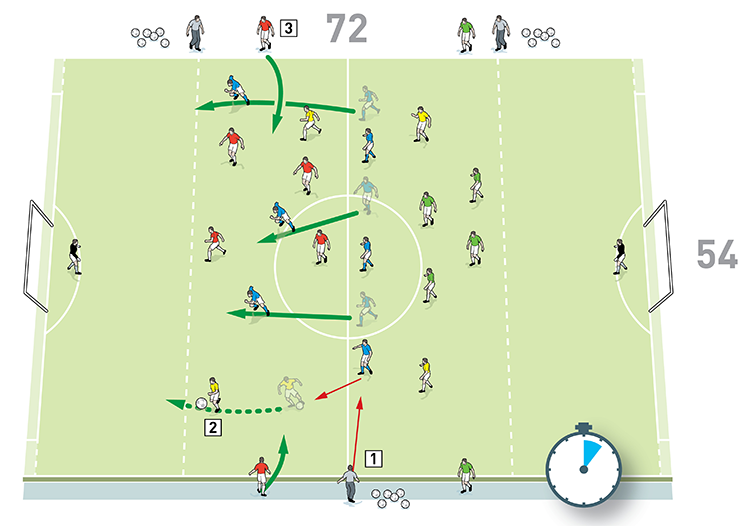
2. The attacking team works quickly to exploit their increased overload, using the help of the yellow floaters in the attacking half
3. The full backs are reintroduced from the touchline after six seconds of the attack
How would you put this into a game situation?
9v9 game
A simple way to implement these ideas in a game situation is to introduce a deep offside line at each end that doubles as a drop off line for the team out of possession.
We’re using 16 outfield players and two goalkeepers, split into two teams of nine. When out off possession the defending team must have all their players in the three quarters of the pitch below the drop off line – this encourages the defending team to defend in a compact way in certain areas and then look for opportunities to attack quickly into space when winning the ball, as shown [3].
3
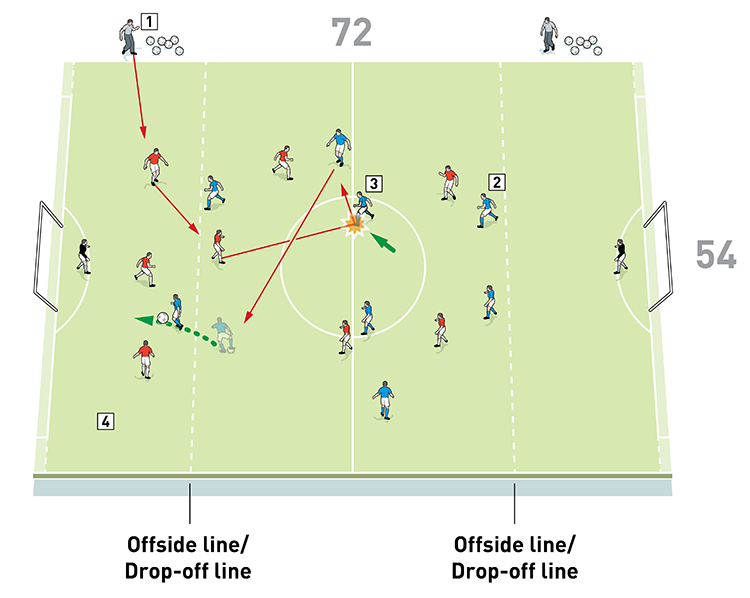
2. When out of possession, teams must stay in the three-quarters of the pitch behind the drop-off line. This will ensure they defend with a compact shape
3. If the defending team wins the ball, they quickly attack the goal
4. If the attackers win a set piece in the final quarter, the servers play a ball to them and players are encouraged to build a controlled attack from the free kick
Additionally, a ball can be played in from the side immediately on the award of any set piece in the attacking quarter. This encourages the team to build sustained and controlled attacks in the opposition half.
What are the key things to look for?
We want to see players making two kinds of attack: fast attacks and controlled attacks. When making fast attacks we are looking for the intent to pass forwards immediately on regaining the ball, with supporting players making forward runs that create overload situations against the defence. We then need to see players exploit the overload with correct decision-making and an effective execution of passes and finishing.
On the controlled attacks, we want the players to take up intelligent positions that stretch the opposition defence, with good ball circulation, off the ball movement and lively combination play to penetrate and create chances.
From the defensive perspective, the players should try to delay the fast attack and deflect the play into wide areas. Then they should reorganise into defensive shape for the second attack and apply more normal defensive principles to stop chances being created.
What are the typical mistakes players might make and how do I avoid them?
Typically, there can be a reluctance to pass forwards and to run forward on regaining the ball – we really have to drum home the importance and value of the early forward pass and encourage the desire to run beyond the ball within our playing style.
On the second attack, the players can be hurried and frantic in possession at times, therefore we need to emphasise the different speeds of attack and the need to change tempo while in possession.
How long does the session last?
The main activity usually lasts about 20 minutes, with the blocks of work dependent on the physical outcomes desired. Usually we would precede this with a 12-minute technical practice [not shown] and a smaller 15-minute overload practice [not shown] that introduce the key attacking themes.
Related Files
Editor's Picks
Deep runs in the final third
Using the goalkeeper in build-up play
Pressing principles
Intensive boxes drill with goals
Penetrating the final third
Creating and finishing
My philosophy
Pressing initiation
Compact team movement
Coaches' Testimonials

Alan Pardew

Arsène Wenger

Brendan Rodgers

Carlos Carvalhal

José Mourinho

Jürgen Klopp

Pep Guardiola

Roy Hodgson

Sir Alex Ferguson

Steven Gerrard
Coaches' Testimonials

Gerald Kearney, Downtown Las Vegas Soccer Club

Paul Butler, Florida, USA

Rick Shields, Springboro, USA

Tony Green, Pierrefonds Titans, Quebec, Canada
Join the world's leading coaches and managers and discover for yourself one of the best kept secrets in coaching. No other training tool on the planet is written or read by the calibre of names you’ll find in Elite Soccer.
In a recent survey 92% of subscribers said Elite Soccer makes them more confident, 89% said it makes them a more effective coach and 91% said it makes them more inspired.
Get Monthly Inspiration
All the latest techniques and approaches
Since 2010 Elite Soccer has given subscribers exclusive insight into the training ground practices of the world’s best coaches. Published in partnership with the League Managers Association we have unparalleled access to the leading lights in the English leagues, as well as a host of international managers.
Elite Soccer exclusively features sessions written by the coaches themselves. There are no observed sessions and no sessions “in the style of”, just first-hand advice delivered direct to you from the coach.









